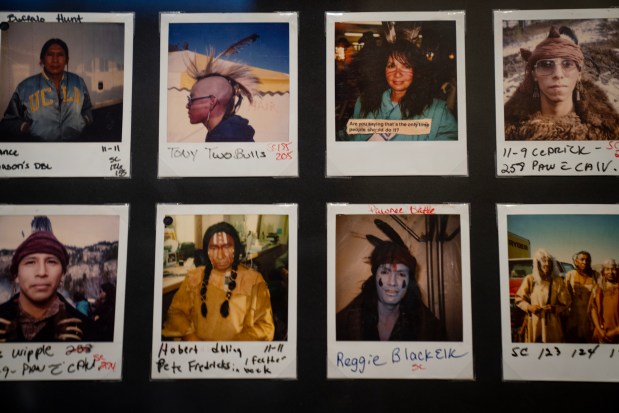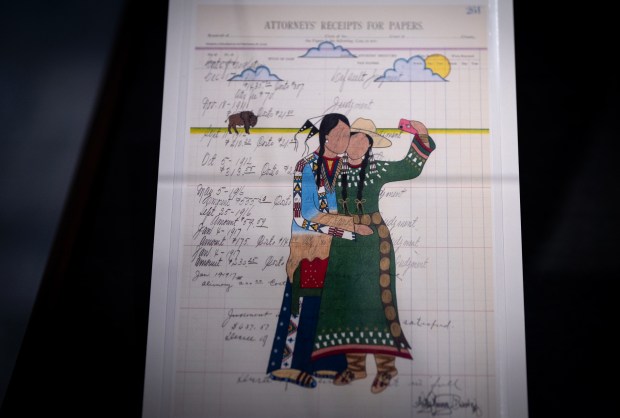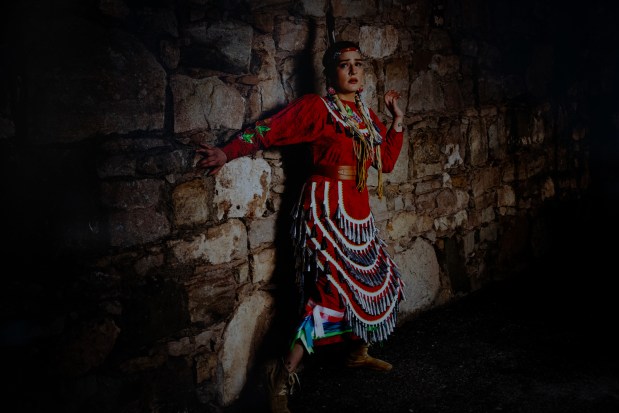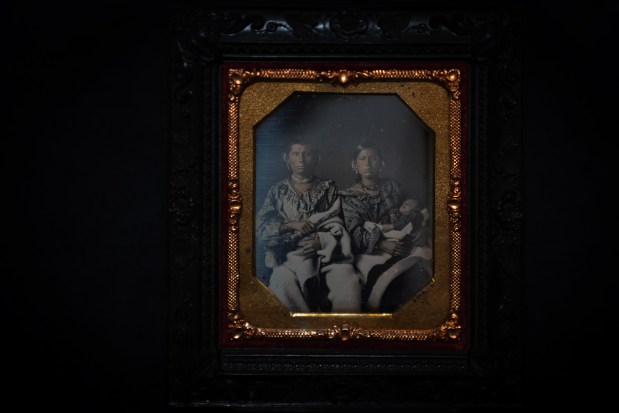When River Kerstetter was asked about three years ago to help curate an exhibit at the Newberry Library about Native Americans and pop culture called “Native Pop!,” she said getting involved with the exhibit was a “no-brainer.”
The artist, who is a member of the Oneida Nation of Wisconsin, had not only worked with archival materials before, but is a self-described nerd.
“I play video games. I read comics. So, yeah, it was just like a perfect fit,” Kerstetter said.
But for Kerstetter, working on the exhibit was more than just an opportunity to learn about different games and comics created by Native people. It was also an opportunity to shape how others think about Native people through mediums such as science fiction, photography and film.
“So, so often Native stories get pigeonholed as ancient history, or it’s very romanticized,” Kerstetter said, emphasizing how Native stories historically have been featured in natural history museums rather than contemporary art museums.
“I think a show like this kind of contextualizes Native people as like, we’re still here. We’ve been here this whole time, and also, we have many diverse perspectives and stories,” Kerstetter said. “And I think pop culture is a really good vehicle to sort of share those stories and kind of get to the heart of what they’re about.”
“Native Pop!” opened on March 20 at the Newberry and features everything from “Star Wars” clips in the Navajo language Diné Bizaad to three video games by Native creators loaded onto an arcade machine specially designed for the exhibit.
The Newberry is home to one of the strongest collections of Native American archival materials in the country. The collection was started in 1911 when American business magnate Edward E. Ayer donated more than 17,000 materials. Ayer’s materials had a strong focus on early contact between Native Americans and European settlers and was later expanded to include materials on Indigenous Hawaiians and Filipinos. In all of these cases, the materials focused on accounts from Europeans and European Americans.
The collection has since grown, but most items in the collection were older materials.
But about five years ago, Hansen said the Newberry formally revised their collection development policy to intentionally focus on gathering more material by Native creators and from the present day.
“We never wanted to have a collection that made people think, ‘Oh, these people used to be around and they’re not anymore,’ which could be the impression you got if we had a collection that really didn’t have a lot from the last century,” said Hansen, who has been with the Newberry for nearly 11 years. “So we’ve been doing much more collecting on material from, say, the second half of the 1900s up to the present day.”

That mission to collect more contemporary materials from Native people is part of what inspired the creation of “Native Pop!” From daguerrotype portraits to Polaroid pictures, the exhibit seeks to not only show Native people in a contemporary context, but also demonstrate how Native people examine and reimagine their past, present and futures.
“I don’t know of an exhibit like ours that has drawn on both rare books, manuscripts and other kinds of artworks that are more historical and put them into a kind of dialogue with more contemporary Indigenous art in the way that ours does,” Hansen said.
Old traditions and contemporary iconography
One primary example of work in the exhibit that mixes the old with the new is ledger art. Its origins are rooted in the practice of people in the Great Plains painting on bison and other animal hides to decorate their everyday items and to tell stories. But that all changed around the mid-19th century with the near extinction of bison.
“When you’re not allowed to roam on the prairie and go kill buffalo or deer and you’re confined to the reservation, you have to find something else,” said Holly Young, a Thizáptaŋna/Wičhíyena Dakota artist located in Bismarck, North Dakota. Then comes the paper from ledger books, which were some of the most common sources of paper Plains people had back in the day.
“And Native people sort of use those kinds of ledgers to tell the kinds of stories that they would have previously told on hides, often exploits in warfare or battle, but other kinds of things too,” including courtship scenes and dances, Hansen said.
Ledger art has seen a revival in the last 40 years. While the ledger paper may be hard to come by, many artists still seek it, scouring eBay, antique stores and trading with other artists for the paper.
Now, some artists are mixing traditional and contemporary imagery in their ledger art to tell their stories. In one of Young’s pieces, two Native people are take a selfie together with a bison in the distance — an image that was inspired by her daughter, who likes to take selfies.

In another piece, created by Hunkpapa Lakota artist Gilbert Kills Pretty Enemy III, an Incredible Hulk is turned into a Native warrior and is seen fighting a black snake that represents an oil pipeline. The piece was created in opposition of the Dakota Access Pipeline, a crude-oil pipeline stretching from North Dakota to Illinois that sparked months-long protests for threatening the drinking water and sacred sites of the Standing Rock Sioux Tribe.
“I just believe with my ledger art, and I’m sure with everyone else too, is we’re just continuing to express ourselves, our culture, our personal experiences, and record and document those,” said Terran Last Gun, a Piikani ledger artist inspired by his father, who gave him his first ledger paper.
Last Gun’s ledger art tends to take on more abstract forms, inspired by both the symbols his tribe paints on their lodges and the bright colors used by Western artists such as Andy Warhol and Roy Lichtenstein. In a piece featured in the exhibit, a yellow and pink hard-edged triangle is juxtaposed against a smaller blue and orange circle in the center. The triangle represents a mountain, a prominent symbol for the Piikani people who are originally from the Rocky Mountains area.
“I like to express to people that there was this geometric, abstract way of thinking already here in North America,” Last Gun said. “I’m very much inspired by Western artists that are doing that type of work too, but it’s very much my own tribal imagery that I’m trying to continue on.”
Cara Romero and photography
Like other pieces in the exhibit, Cara Romero uses her photography to tell the stories and experiences of Native people in the modern day — but she didn’t always intend to become a photographer. Romero, who currently lives in New Mexico, stumbled into a black-and-white film photography class in college, and while she lacked some of the technical skills, she quickly fell in love with it.
“It was one of those professors and one of those college courses that really opened up my heart and mind to different possibilities,” said Romero, an enrolled citizen of the Chemehuevi Indian Tribe. “Wanting to communicate the contemporary, lived experience of native peoples and my community was something that I was really searching for — and I just instantly understood that photography was going to be the vehicle for communication.”

In a photo titled “Dans l’Ombre,” which translates to “in the shadows” in French, Romero plays on the film noir genre. A woman is dressed in traditional Native American clothing and backed up against a wall with a scared expression on her face. What she is fearful of is left up to the viewer to imagine. The woman is wearing a red dress — symbolizing the epidemic of Missing and Murdered Indigenous Women.
“I think within the Native community, we understand what might be in the shadows, but it’s really a chance for, cross-culturally, non-Native people to wonder and hopefully explore what she might be scared of,” Romero said.
Another important aspect of Romero’s work is helping young people understand their origins and Native culture, as well as their place in the modern day.
“Indigeneity becomes this timeless way to visually communicate that we are both modern and still carry all of that ancestral knowledge and cultural transmission, even though we’re living in contemporary times,” Romero said. “And I think that that’s really important, primarily for our young people, to have that cross-cultural understanding that they’re every bit as Indigenous as they ever were in these contemporary times.”
Romero does just that in a featured photo called “Coyote Tales no. 1.” The photo is inspired by the tale of the trickster but heroic coyote, who appears in hundreds of tales across different tribes. The coyote represents the side of humanity that is always making mistakes and learning from those mistakes, but is still loved regardless. In the image, the coyote is turned away from the viewer while two women in the photo look forward. The coyote is hiding a pair of flowers, suggesting that he intends to give one of the women the flowers, but his intentions are left to the viewer to ponder.
“There’s ideas of painting the town red, of whatever is about to happen if the coyote is involved, there’s bound to be some lessons learned,” Romero said. “But the girls look very in control … And so it just kind of became this really beautiful composition that, for me, is really fun. It kind of brings back our storytelling into contemporary times, instead of just in, you know, ancient context.”
“Native Pop!” runs through June 19 at the Newberry Library, 60 W. Walton St.. The galleries are open Tuesday to Thursday from 10 a.m. to 7 p.m. and Friday to Saturday from 10 a.m. to 5 p.m. Entry is free; more information at collections.newberry.org




